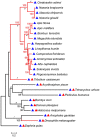Adaptive evolution of the circadian gene timeout in insects
- PMID: 24572761
- PMCID: PMC3936262
- DOI: 10.1038/srep04212
Adaptive evolution of the circadian gene timeout in insects
Abstract
Most insects harbor two paralogous circadian genes, namely timeout and timeless. However, in the Hymenoptera only timeout is present. It remains unclear whether both genes, especially timeout in hymenopteran insects, have distinct evolutionary patterns. In this study, we examine the molecular evolution of both genes in 25 arthropod species, for which whole genome data are available, with addition of the daily expression of the timeout gene in a pollinating fig wasp, Ceratosolen solmsi (Hymenoptera: Chalcidoidea: Agaonidae). Timeless is under stronger purifying selection than timeout, and timeout has positively selected sites in insects, especially in the Hymenoptera. Within the Hymenoptera, the function of timeout may be conserved in bees and ants, but still evolving rapidly in some wasps such as the chalcids. In fig wasps, timeout is rhythmically expressed only in females when outside of the fig syconium but arrhythmically in male and female wasps inside the syconium. These plastic gene expressions reflect adaptive differences of males and females to their environment.
Figures



Similar articles
-
Expression and evolutionary divergence of the non-conventional olfactory receptor in four species of fig wasp associated with one species of fig.BMC Evol Biol. 2009 Feb 20;9:43. doi: 10.1186/1471-2148-9-43. BMC Evol Biol. 2009. PMID: 19232102 Free PMC article.
-
Adaptive evolution of vertebrate-type cryptochrome in the ancestors of Hymenoptera.Biol Lett. 2013 Feb 23;9(1):20120958. doi: 10.1098/rsbl.2012.0958. Print 2013 Feb 23. Biol Lett. 2013. PMID: 23221878 Free PMC article.
-
Phylogeny and evolution of life-history strategies in the Sycophaginae non-pollinating fig wasps (Hymenoptera, Chalcidoidea).BMC Evol Biol. 2011 Jun 22;11:178. doi: 10.1186/1471-2148-11-178. BMC Evol Biol. 2011. PMID: 21696591 Free PMC article.
-
Evolution of Cuticular Hydrocarbons in the Hymenoptera: a Meta-Analysis.J Chem Ecol. 2015 Oct;41(10):871-83. doi: 10.1007/s10886-015-0631-5. Epub 2015 Sep 26. J Chem Ecol. 2015. PMID: 26410609 Free PMC article. Review.
-
Demographic mechanisms for the evolution of long life in social insects.Exp Gerontol. 2001 Apr;36(4-6):713-22. doi: 10.1016/s0531-5565(00)00237-0. Exp Gerontol. 2001. PMID: 11295510 Review.
Cited by
-
Potential conservation of circadian clock proteins in the phylum Nematoda as revealed by bioinformatic searches.PLoS One. 2014 Nov 14;9(11):e112871. doi: 10.1371/journal.pone.0112871. eCollection 2014. PLoS One. 2014. PMID: 25396739 Free PMC article.
-
Circadian Activity and Clock Genes in Pachycrepoideus vindemmiae: Implications for Field Applications and Circadian Clock Mechanisms of Parasitoid Wasps.Insects. 2023 May 22;14(5):486. doi: 10.3390/insects14050486. Insects. 2023. PMID: 37233114 Free PMC article.
-
Annotation of putative circadian rhythm-associated genes in Diaphorina citri (Hemiptera: Liviidae).GigaByte. 2022 Apr 1;2022:gigabyte48. doi: 10.46471/gigabyte.48. eCollection 2022. GigaByte. 2022. PMID: 36824532 Free PMC article.
-
The nuclear and mitochondrial genomes of Frieseomelitta varia - a highly eusocial stingless bee (Meliponini) with a permanently sterile worker caste.BMC Genomics. 2020 Jun 3;21(1):386. doi: 10.1186/s12864-020-06784-8. BMC Genomics. 2020. PMID: 32493270 Free PMC article.
-
The effect of Wolbachia on diapause, fecundity, and clock gene expression in Trichogramma brassicae (Hymenoptera: Trichogrammatidae).Dev Genes Evol. 2017 Nov;227(6):401-410. doi: 10.1007/s00427-017-0597-0. Epub 2017 Nov 29. Dev Genes Evol. 2017. PMID: 29188381
References
-
- Myers M. P., Wager-Smith K., Wesley C. S., Young M. W. & Sehgal A. Positional cloning and sequence analysis of the Drosophila clock gene, timeless. Science 270, 805–808, 10.1126/science.270.5237.805 (1995). - PubMed
-
- Benna C. et al. A second timeless gene in Drosophila shares greater sequence similarity with mammalian tim. Curr. Biol. 10, R512–R513, 10.1016/S0960-9822(00)00594-7 (2000). - PubMed
Publication types
MeSH terms
LinkOut - more resources
Full Text Sources
Other Literature Sources

